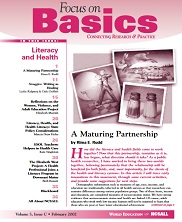This issue of Focus on Basics explores some of the many ways in which literacy and health partnerships are enacted. They tend to fall into two categories: approaches that seek to empower students to navigate more easily the often overwhelming U,S. healthcare system, and approaches that seek to educate literacy students about and alleviate health problems.
NCSALL researcher Rima Rudd sketches out the history of the growing interaction between the two fields. In addition, Rudd describes the diffusion of innovation theory, which helps to explain how and why this interaction came about. This theory also sheds light on why students are so effective in catalyzing their peers to act on health-related issues.
Students acting together in activities related to health are described by Beth Russett, on page 30, in an account of her year as a nurse practitioner providing health education in a Laubach program in Maine. Also concerned about students’ health needs, ESOL teacher Kate Singleton turned familiar issues into evocative classroom materials. As students built their conversation skills, they learned how to access resources available in Virginia, such as low-cost health care and translation services within the health care system. Her story starts on page 26.
Violence is not always recognized as a health issue, but teachers across the country are increasingly recognizing its role in impeding learning. The Women, Violence, and Adult Education project described in the article by Elizabeth Morrish, page 15, enabled participating programs to explore ways to address this educational barrier, not necessarily by dealing with it directly but by focusing on wellness itself. On page 11, Leslie Ridgeway and Dale Griffith provide an inside view of how this worked at their program in the York Correctional Institute in Connecticut.
A successful marriage between literacy and health—and all the related benefits that result—cannot come about solely through the acts of individuals and programs. State-level policy must play a role as well. Marcia Hohn interviewed five state policy-makers to learn how they are supporting efforts to bring health and literacy together in their respective states. She shares six strategies in the article that starts on page 20. World Education, 2002.


